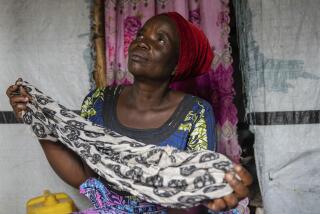New Services Surface to Help Victims Cope After Terrorist Attacks
- Share via
They are not a psychologist’s typical clients:
- The guilt-ridden postal worker who had called in sick Aug. 20, the day Patrick Sherill went on a shooting rampage in an Edmond, Okla., post office, killing 14 people and then himself.
- The men, women and children who escaped a nightmarish shoot-out aboard a Pan American Airlines jet in Karachi, Pakistan, Sept. 5, then lined up two days later to find their blood-soaked luggage before boarding another plane.
- The police officer at the July 18, 1984, massacre in the San Ysidro McDonald’s restaurant, whose child was wearing the same shirt as one of the youngsters murdered by James Huberty.
But as the growing number of terrorist attacks and occasional random acts of mass violence have become a fact of modern life, these people are increasingly asking psychologists for help and presenting them with special problems to solve.
That trend was highlighted this weekend during the 1987 California State Psychological Assn. convention at the Hotel del Coronado. Among the many workshops and symposiums on such topics as child abuse, psychopathology and psychologists’ legal rights were speakers on three panels discussing the trauma associated with terrorism, hostage-taking, random violence and disasters.
“Twelve years ago, when I began working in this field, (terrorism) was a very low-profile topic where the probability of this type of incident and hostage-taking affecting the lives of citizens was very, very small,” said Chris Hatcher, chairman of the association’s task force on terrorism. “Now . . . we have a rather large number (of people) whose personal lives will be touched.”
“We tend to think that the victims are only the people who are directly involved,” said Michael Mantell, chief psychologist for the San Diego Police Department, who worked in the aftermath of massacres in the San Ysidro McDonald’s and the Edmond post office. “The point of this research was to say, ‘Hey, world, victims come from all over, and they’re people who you don’t even think about’.”
Who are the victims? In addition to ex-hostages and survivors of terrorist attacks, they are the police and emergency medical technicians shattered by what they see at the scene. They are the wives, husbands and children of those involved, who no longer feel safe. They are bystanders who saw it all happen but could do nothing to help.
Psychologists also note that terrorism and unprovoked attacks also make people jittery, though few who simply read of these incidents in their newspaper show up for therapy.
Nevertheless, hostage-taking scenarios are appearing more frequently in movies and television shows, Hatcher said. And people are altering their behavior. There are fewer cruises in the Mediterranean and more in the Caribbean since the Achille Lauro hijacking, and air traffic in Athens has decreased since the bombing of an airplane there, Hatcher said.
“Some people have said that the odds of being a hostage in Western Europe or the Middle East are the same as being struck by lightning in the U.S.,” Hatcher said. “While that may be true, a significant number of people’s behavior has been altered by these events.”
“When you and I get on a plane and we’re worried about a bomb, that’s terrorism,” said Mantell, who calls massacres like the ones in San Ysidro and Edmond local terrorism. “There doesn’t have to be a bomb. The bomb is secondary.”
According to the Rand Corp. of Santa Monica, 138 international terrorist incidents caused 37 deaths in 1968, the first year the company started counting. In 1985, the worst year to date, there were 484 incidents and 878 deaths. Last year, the figures dropped slightly to 415 incidents and 400 fatalities.
The Rand count includes only politically motivated attacks by terrorists against people or institutions in another country. The violence in Northern Ireland and fighting between Lebanese factions, for example, is not included.
Rand lists 37 terrorist incidents and three deaths in the United States and Puerto Rico last year, down from the 52 incidents that also caused three deaths in 1985.
This expanding violence has created new challenges and opportunities for psychologists, including helping to prepare people for violent episodes. Major corporations now routinely advise their executives about how to decrease the risks of traveling to unstable areas abroad, Hatcher said.
The businessmen are cautioned to disguise obvious clues that identify them as wealthy American industrialists. Executives should not keep corporate identification in carry-on baggage, wear expensive jewelry and watches, travel first class (a recommendation often ignored) or dress in expensive suits, Hatcher said.
If they are taken hostage and singled out, captives are advised to try to communicate with their captors. Talking about their children and families may make the captive more “human” and therefore less likely to be killed, Hatcher said.
But that is not always true. Throughout the Karachi incident, the leader of the hijackers played with a small boy and conversed with his father, showing them so much attention that some passengers began to wonder if they were involved in the takeover, Hatcher said. But when the shooting began, the hijackers’ leader killed them both, he said.
Other preparation for hostage-taking includes the seminars that psychologist Richard L. Farley conducts with religious organizations that send missionaries abroad.
Farley, a San Diego private practitioner and reserve lieutenant in the Navy’s Medical Service Corps, teaches the travelers the techniques of relaxation and self-hypnosis--better understood as “structured daydreaming”--as methods of enduring prolonged captivity and isolation.
“It’s the growth industry of the ‘80s--taking hostages,” Farley explained.
Similar relaxation techniques are used by officers of the San Diego County Sheriff’s Department’s Special Enforcement Detail, who may be forced to wait for hours under highly stressful conditions before storming a building in a hostage-taking or armed standoff, said Lt. Dennis Cole, the squad’s commander.
Mantell specializes in treating police officers with symptoms of post-traumatic stress disorder. They turn up complaining of sleep difficulties, trouble concentrating, headaches, guilt that they were not more helpful and feelings of helplessness, he said.
In a study of the San Ysidro massacre for the National Institute of Mental Health, Mantell found that half the police officers involved showed “mild to severe” post-traumatic stress six months after the incident.
“One officer threw up at the scene (of the McDonald’s massacre),” Mantell said. “He put his arm around me and put his head on my shoulder and sobbed like a baby. He said to me ‘Doc, when I left the house this morning my kid was wearing the same shirt as that kid (who was killed).”
It can take weeks or months for the early symptoms to subside. Some feelings never go away.
“My images of McDonald’s are always with me,” said Mantell, who was at the scene offering counseling within hours of the tragedy. “That doesn’t mean that’s something abnormal. It’s just something you live with. It’s like any other thing that’s emotionally traumatic. It’s burned into your mind.”
In such incidents, the counseling process generally follows this pattern: Police officers are “emotionally debriefed”--encouraged to talk about the incident as much as possible despite their usually strong desire to forget. Mantell asks them to recall the sights, smells and sounds that were part of the horror.
Counselors stress that their clients are safe and secure, that the violence is over and that they will not be hurt. They tell them that their feelings are normal reactions experienced by many of their peers, Mantell said.
Counselors also predict the symptoms that police and others will suffer in the coming weeks, in an attempt to reduce the fear those symptoms will generate.
Mantell’s research findings showed that police who talked about their horror, who “actively explored the issue and searched for information about the tragedy after it ended, fared better.”
“Officers who had more people to share their feelings with had fewer symptoms than those who had to play Rambo or Rambette,” he said.
Politically motivated international terrorism creates a range of tasks for psychologists like Hatcher, who for nine years served as a consultant to the U.S. House of Representatives Foreign Affairs Committee and has assisted the government in 30 terrorist incidents, including the 1979 takeover of the U.S. Embassy in Tehran.
During the past decade, psychologists have begun to study the phenomenon of terrorism and the behavior of survivors and their families during and after the incident. Others are helping diplomats and law enforcement agencies to resolve such incidents, he said.
Hatcher’s interviews with more than 100 surviving hostages revealed that lengthy captivity creates extra problems. Days or weeks of terror provide extra time to think, which leads to more second-guessing and more guilt after release or escape, Hatcher said.
He “has the potential option to perform with respect, or even heroically. It means that person has a great deal of guilt afterward (over) not performing those actions, like grabbing the gun.”
If another captive who acted heroically is killed, the feelings of guilt can be stronger. Several survivors of the Karachi takeover recalled an elderly woman who passed out candy during the ordeal and a flight attendant who, despite threats and abuse from the terrorists, continued to calm passengers and tried to pacify the captors.
Both women were killed, and some survivors later voiced feelings that they were not as worthy as the two who had perished.
“Unfortunately, these types of incidents are affecting an increasingly large number of citizens and their families,” he said. “The average psychologist should understand (how to respond), just as he understand the basics of what you should do for an individual involved in a shooting.”
More to Read
Sign up for Essential California
The most important California stories and recommendations in your inbox every morning.
You may occasionally receive promotional content from the Los Angeles Times.










